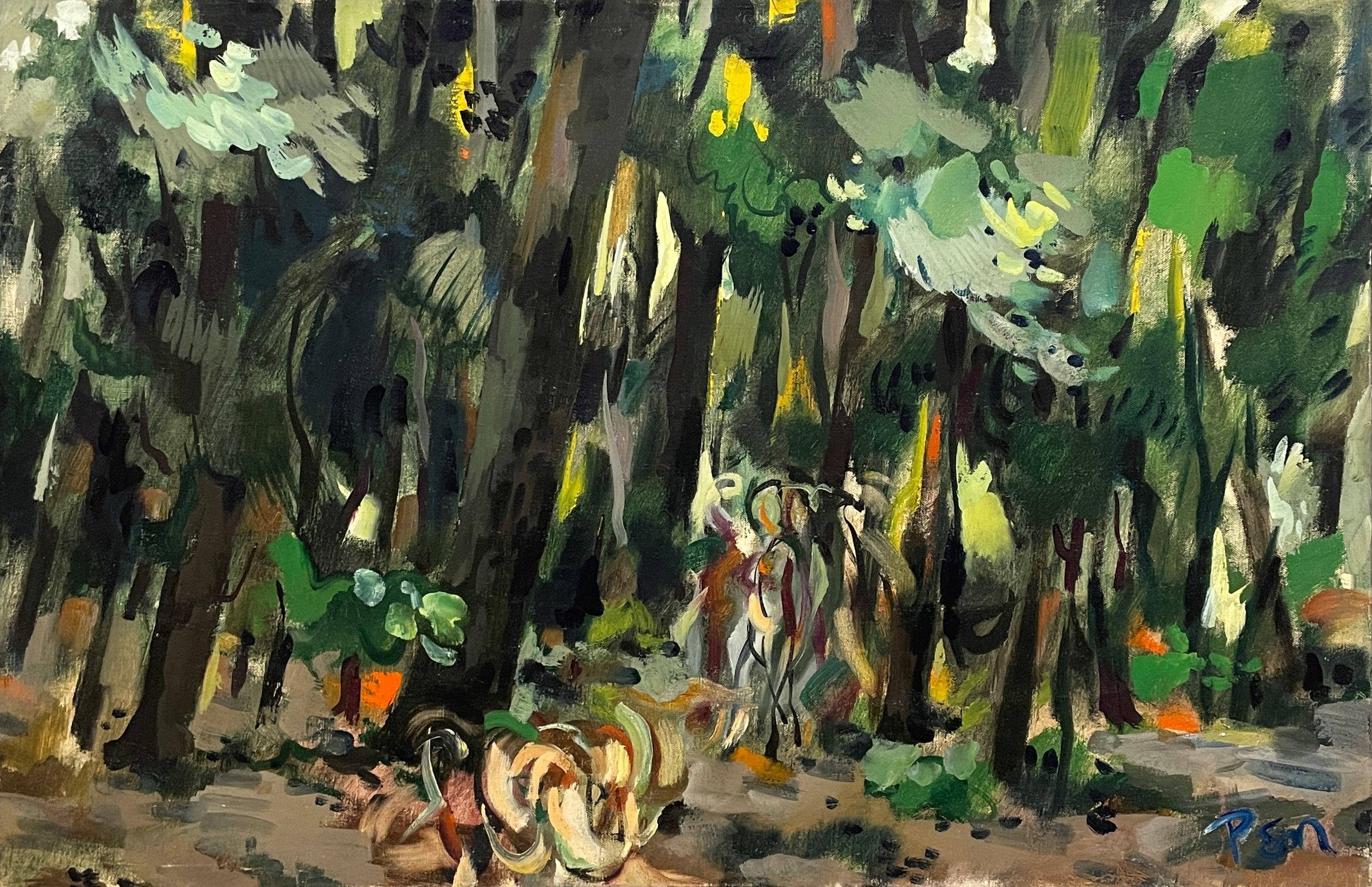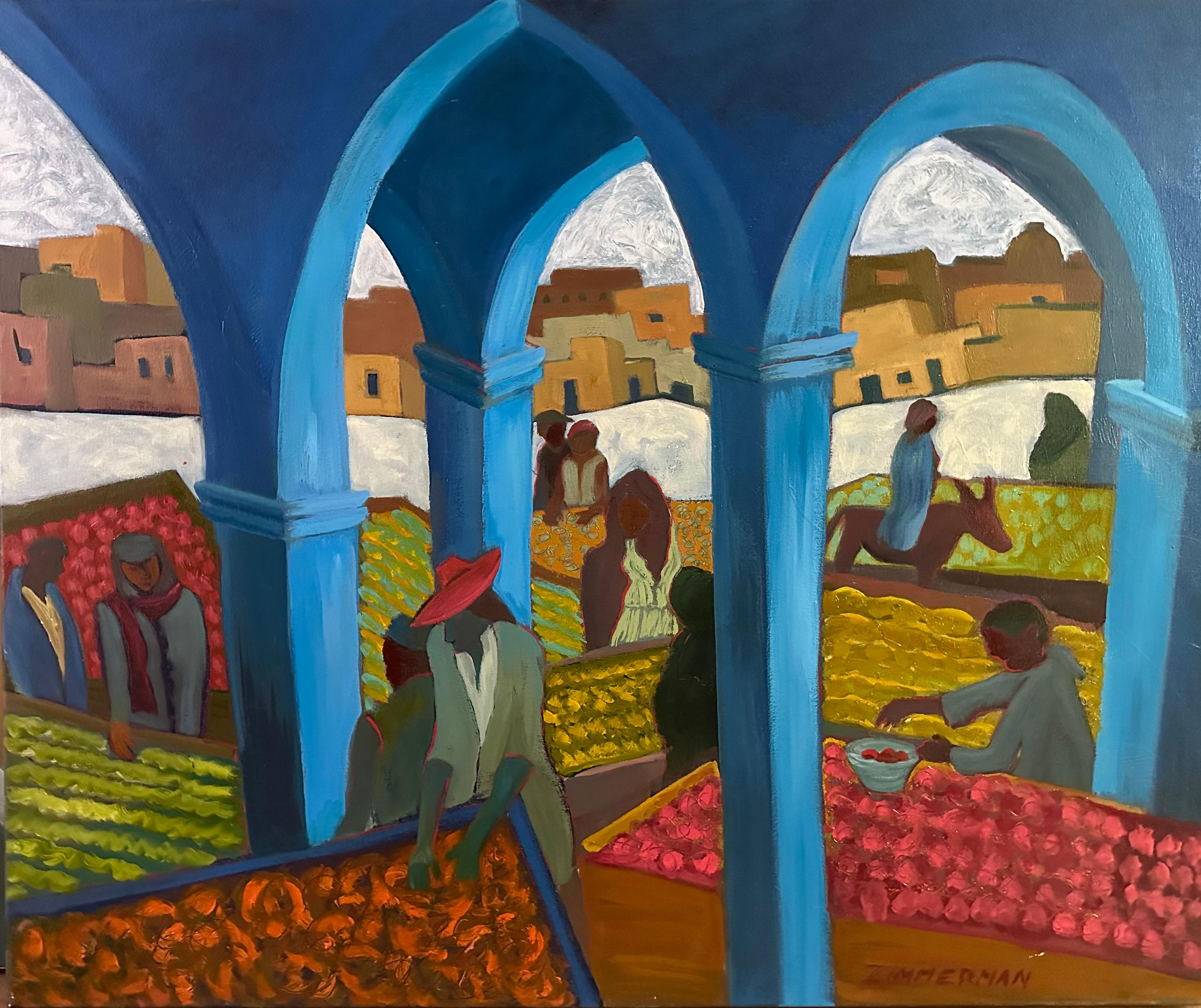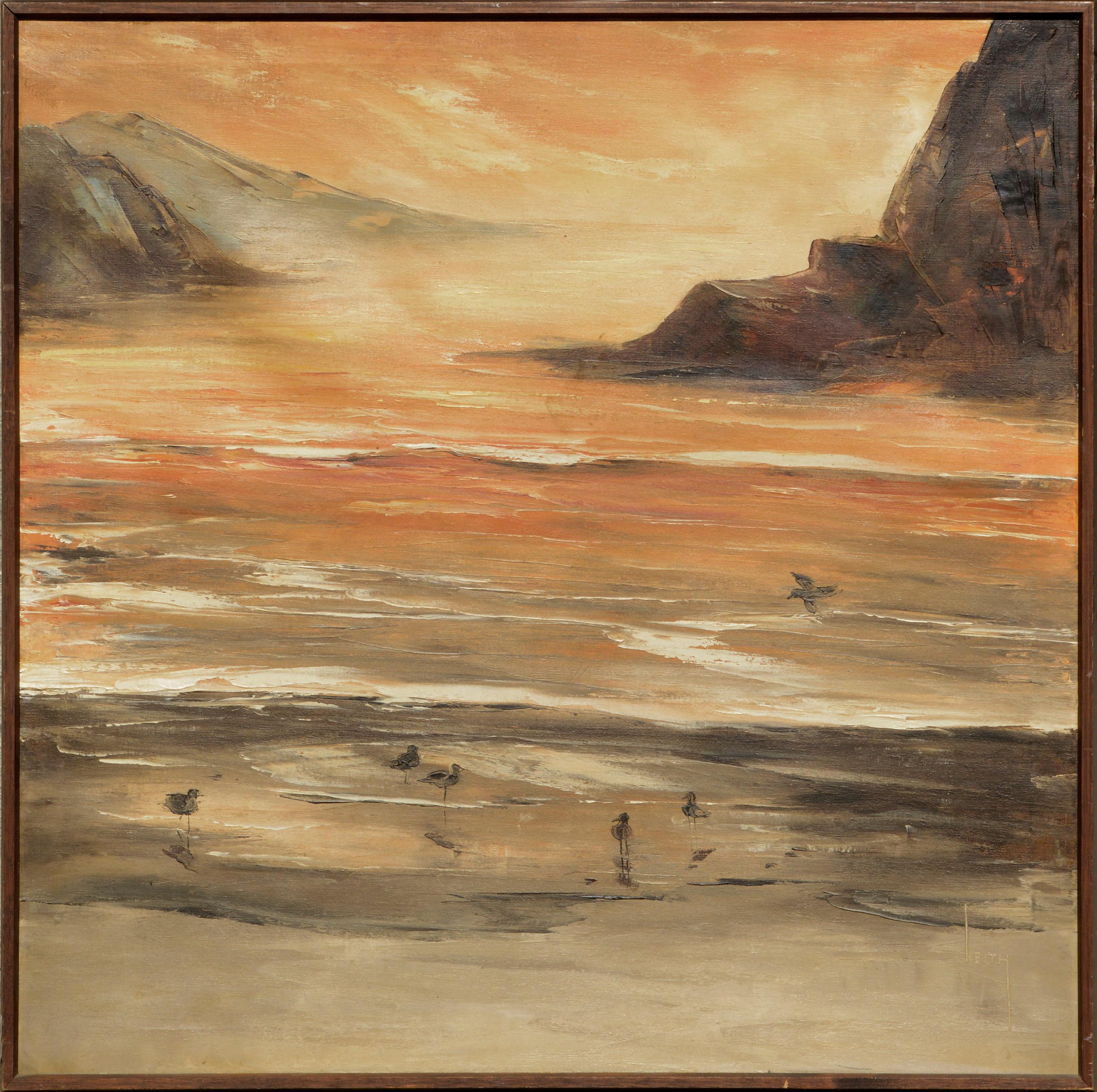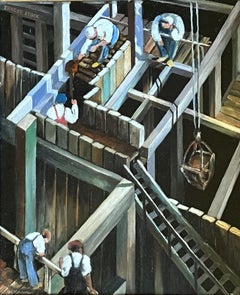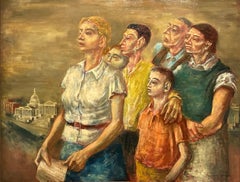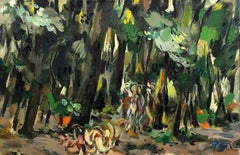Items Similar to Six O'Clock
Want more images or videos?
Request additional images or videos from the seller
1 of 5
Thomas CraigSix O'Clock
About the Item
Six O-Clock, c. 1942, oil on canvas, 30 x 20 inches, signed and titled several times verso of frame and stretcher (perhaps by another hand), marked “Rehn” several times on frame (for the Frank K. M. Rehn Galleries in New York City, who represented Craig at the time); Exhibited: 1) 18th Biennial Exhibition of Contemporary American Oil Paintings from March 21 to May 2, 1943 at The Corcoran Gallery of Art in Washington, D.C. #87, original price $450 (per catalog) (exhibition label verso), 2) Craig’s one-man show at the Frank K. M. Rehn Galleries, New York City, from October 26 to November 14, 1942, #10 (original price listed as $350); and 3) Exhibition of thirty paintings sponsored by the Harrisburg Art Association at the State Museum of Pennsylvania in Harrisburg in March, 1944 (concerning this exhibit, Penelope Redd of The Evening News (Harrisburg, Pennsylvania) wrote: “Other paintings that have overtones of superrealism inherent in the subjects include Tom Craig’s California nocturne, ‘Six O’Clock,’ two figures moving through the twilight . . . .” March 6, 1944, p. 13); another label verso from The Museum of Art of Toledo (Ohio): original frame: Provenance includes George Stern Gallery, Los Angeles, CA
About the Painting
Long before Chris Burden’s iconic installation outside of the Los Angeles County Museum of Art, Urban Light, another artist, Tom Craig, made Southern California streetlights the subject of one of his early 1940s paintings. Consisting of dozens of recycled streetlights from the 1920s and 1930s forming a classical colonnade at the museum’s entrance, Burden’s Urban Light has become a symbol of Los Angeles. For Burden, the streetlights represent what constitutes an advanced society, something “safe after dark and beautiful to behold.” It seems that Craig is playing on the same theme in Six O-Clock. Although we see two hunched figures trudging along the sidewalk at the end of a long day, the real stars of this painting are the streetlights which brighten the twilight and silhouette another iconic symbol of Los Angeles, the palm trees in the distance. Mountains in the background and the distant view of a suburban neighborhood join the streetlights and palm trees as classic subject matter for a California Scene painting, but Craig gives us a twist by depicting the scene not as a sun-drenched natural expanse. Rather, Craig uses thin layers of oil paint, mimicking the watercolor technique for which he is most famous, to show us the twinkling beauty of manmade light and the safety it affords. Although Southern California is a land of natural wonders, the interventions of humanity are already everywhere in Los Angeles and as one critic noted, the resulting painting has an air of “superrealism.”
About the Artist
Thomas Theodore Craig was a well-known fixture in the Southern California art scene. He was born in Upland California. Craig graduated with a degree in botany from Pomona College and studied painting at Pamona and the Chouinard Art School with Stanton MacDonald-Wright and Barse Miller among others. He became close friends with fellow artist Milford Zornes during his time at Pamona and both artists also studied under Millard Sheets, who encouraged Craig to paint seriously. During the 1930s and 1940s, Craig taught at the University of California, Occidental College and Chouinard. In 1937, his work was included in a traveling exhibition called “The California Group” which helped cement his reputation as one of the leading California Scene painters. He showed at dozens of other exhibitions as well, including at the California Art Club, the San Diego Art Guild, the Corcoran Gallery, the American Artists Congress, the Golden Gate International Exhibition, the Art Institute of Chicago, the Pennsylvania Academy of Fine Arts, and the Los Angeles County Museum of Art, among other institutions. Craig was awarded prizes by the Los Angeles Art Association, Los Angeles County Fair, Seattle Art Museum, California Watercolor Society, California State Fair, Oakland Art Museum, Laguna Beach Fine Arts Gallery, San Diego Artists Guild, Portland Art Museum, Golden Gate International Exposition. Around the time he painted Six O’Clock, Craig won a Guggenheim Fellowship in 1941 which facilitated travel and further pursuit of his art career. During World War II, Craig served as an artist-correspondent for Life Magazine. After returning from the War, Craig’s artist output slowed, and he devoted most of his time to botany after 1950, making his work relatively rare. He is represented in the permanent collections of the Metropolitan Museum of Art, Seattle Art Museum, San Francisco Museum of Art, California Palace of the Legion of Honor, The Hilbert Museum of California Art, and the Los Angeles County Museum of Art.
- Creator:Thomas Craig (1849 - 1924)
- Dimensions:Height: 20 in (50.8 cm)Width: 30 in (76.2 cm)Depth: 2 in (5.08 cm)
- More Editions & Sizes:20 x 30 inchesPrice: $12,500
- Medium:
- Movement & Style:
- Period:
- Condition:
- Gallery Location:Los Angeles, CA
- Reference Number:1stDibs: LU1859211388952
About the Seller
5.0
Gold Seller
Premium sellers maintaining a 4.3+ rating and 24-hour response times
1stDibs seller since 2022
14 sales on 1stDibs
Typical response time: 19 hours
- ShippingRetrieving quote...Shipping from: Los Angeles, CA
- Return Policy
Authenticity Guarantee
In the unlikely event there’s an issue with an item’s authenticity, contact us within 1 year for a full refund. DetailsMoney-Back Guarantee
If your item is not as described, is damaged in transit, or does not arrive, contact us within 7 days for a full refund. Details24-Hour Cancellation
You have a 24-hour grace period in which to reconsider your purchase, with no questions asked.Vetted Professional Sellers
Our world-class sellers must adhere to strict standards for service and quality, maintaining the integrity of our listings.Price-Match Guarantee
If you find that a seller listed the same item for a lower price elsewhere, we’ll match it.Trusted Global Delivery
Our best-in-class carrier network provides specialized shipping options worldwide, including custom delivery.More From This Seller
View AllSubway Construction
Located in Los Angeles, CA
This painting is part of our exhibition American Coast to Coast: Artists of the 1930s
Subway Construction, c. 1928, oil on board, 19 x 15 ¾ inches, signed upper left, artist and title verso; exhibited: 1) 12th Annual Exhibition of the Society of Independent Artists, The Waldorf Astoria, New York NY, from March 9 to April 1, 1928, no. 864 (original price $250) (see Death Prevailing Theme of Artists in Weird Exhibits, The Gazette (Montreal, Quebec, Canada), March 8, 1928); 2) Boston Tercentenary Exhibition Fine Arts and Crafts Exhibition, Horticultural Hall, Boston MA, July, 1930, no. 108 (honorable mention - noted verso); 3) 38th Annual Exhibition of American Art, Cincinnati Art Museum, Cincinnati, OH, June, 1931 (see Alexander, Mary, The Week in Art Circles, The Cincinnati Enquirer, June 7, 1931); and 4) National Art Week Exhibition [Group Show], Montross Gallery, New York, New York, December, 1940 (see Devree, Howard, Brief Comment on Some Recently Opened Exhibitions in the Galleries, The New York Times, December 1, 1940)
About the Painting
Ernest Stock’s Subway Construction depicts the excavation of New York’s 8th Avenue line, which was the first completed section of the city-operated Independent Subway System (IND). The groundbreaking ceremony was in 1925, but the line did not open until 1932, placing Stock’s painting in the middle of the construction effort. The 8th Avenue line was primarily constructed using the “cut and cover” method in which the streets above the line were dug up, infrastructure was built from the surface level down, the resulting holes were filled, and the streets reconstructed. While many artists of the 1920s were fascinated with the upward thrust of New York’s exploding skyline as architects and developers sought to erect ever higher buildings, Stock turned his attention to the engineering marvels which were taking place below ground. In Subway Construction, Stock depicts workers removing the earth beneath the street and building scaffolding and other support structures to allow concrete to be poured. Light and shadow fall across the x-shaped grid pattern formed by the wooden beams and planks. It is no surprise that critics reviewing the painting commented on Stock’s use of an “interesting pattern” to form a painting that is “clever and well designed.”
About the Artist
Ernest Richard Stock was an award-winning painter, print maker, muralist, and commercial artist. He was born in Bristol, England and was educated at the prestigious Bristol Grammar School. During World War I, Stock joined the British Royal Air Flying Corps in Canada and served in France as a pilot where he was wounded. After the war, he immigrated to the United States and joined the firm of Mack, Jenny, and Tyler, where he further honed his architectural and decorative painting skills. During the 1920s, Stock often traveled back and forth between the US and Europe. He was twice married, including to the American author, Katherine Anne Porter. Starting in the mid-1920s, Stock began to exhibit his artwork professionally, including at London’s Beaux Arts Gallery, the Society of Independent Artists, the Salons of America, the Cincinnati Art Museum, the Whitney Studio and various locations in the Northeast. Critics often praised the strong design sensibility in Stock’s paintings. Stock was a commercial illustrator for a handful of published books and during World War II, he worked in the Stratford Connecticut...
Category
1920s American Modern Figurative Paintings
Materials
Oil
Rabbit Hunters
By Roger Medearis
Located in Los Angeles, CA
Rabbit Hunters, egg tempera on Masonite, 12 x 9 inches, 1947, signed and dated lower left, signed, titled and dated verso “Rabbit Hunters Egg Tempera Roger Medearis 1947,” exhibited at Medearis' solo show at Kende Galleries, New York, in 1949 (Medearis’ record book, a copy of which is held by Vose Galleries in Boston, MA, indicates this is painting “No. 23” and that is was completed in 1947 and sold via Kende Galleries (at Gimbel Brothers...
Category
1940s American Modern Landscape Paintings
Materials
Tempera, Board
The People
By Arnold Blanch
Located in Los Angeles, CA
The People, 1938, oil on canvas, signed lower right, 36 x 48 inches, label verso reads “348 / 89 / Carnegie Institute, Pittsburgh, PA, USA / _____ The People / _______ Arnold Blanch ...
Category
1930s American Realist Figurative Paintings
Materials
Canvas, Oil
Knight’s Lodging
Located in Los Angeles, CA
This painting is part of our exhibition American Coast to Coast: Artists of the 1930s
Knight’s Lodging, 1941, oil on canvas panel, signed and dated lower left, 16 x 20 inches, exhi...
Category
1940s American Realist Figurative Paintings
Materials
Oil
Factory Worker
Located in Los Angeles, CA
This painting is part of our exhibition America Coast to Coast: Artists of the 1930s
Factory Worker, c. 1936, oil on canvas, signed lower right, 18 ¼ x 36 inches; exhibited in City ...
Category
1930s American Realist Figurative Paintings
Materials
Oil
Industry and Commerce
Located in Los Angeles, CA
This mural study is part of our exhibition America Coast to Coast: Artists of the 1930s
Industry and Commerce, 1936, tempera on panel, 16 ½ x 39 ½ inches, signed verso “John Ballator, Portland Ore.” provenance includes: J.C. Penney Company, represented by Russell Tether Fine Arts Assoc.; presented in a newer wood frame
About the Painting
Industry and Commerce is a prime example of WPA Era muralism. Like a Mediaeval alter, this mural study is filled with icons, but the images of saints and martyrs are replaced with symbols of America's gospel of prosperity through capitalism. Industry and Commerce has a strong narrative quality with vignettes filling the entire surface. Extraction, logistics, design, power generation, and manufacturing for printing, chemicals, automobiles and metal products are all represented. To eliminate any doubt about the mural's themes, Ballator letters a description into the bottom of the study. Ballator also presents an idealized version of industrial cooperation, as his workers, lab-coated technicians and tie-wearing managers work harmoniously toward a common goal in the tidy and neatly designed environments. Although far from the reality of most industrial spaces, Ballator's study reflects the idealized and morale boosting tone that many mural projects adopted during the Great Depression.
About the Artist
John R Ballator achieved success as a muralist, lithographer, and teacher during the Great Depression. Born in Oregon, he studied at the Portland Museum Art School, the University of Oregon and at Yale University where he received a Bachelor of Fine Art. In 1936, Ballator was commissioned to paint a mural panel for the new Department of Justice Building in Washington DC, an important project that spanned five years with several dozen artists contributing a total of sixty-eight designs. Ballator completed murals for the St. Johns Post Office and Franklin High School, both in Portland, Oregon. He also contributed to the 1938 murals at Nathan Hale School in New Haven, Connecticut. During the late 1930s, Ballator taught art for several years at Washburn College in Topeka, Kanas, where he completed a mural for the Menninger Arts & Craft Shop before accepting a professorship at Hollins College...
Category
1930s American Realist Figurative Paintings
Materials
Tempera
You May Also Like
"Glassblowers" American Scene Social Realism Mid-20th Century New York City WPA
By Ernest Fiene
Located in New York, NY
"Glassblowers" American Scene Social Realism Mid-20th Century New York City WPA
Ernest Fiene (1894-1965)
Glass Blowers
28 x 23 inches
Oil on canvas board
Signed and dated 1944 lower...
Category
1940s American Modern Figurative Paintings
Materials
Oil, Canvas
A Vibrant, Colorful Mid-Century Summer Landscape, Oxbow School, Saugatuck, MI
Located in Chicago, IL
A Vibrant, Captivating Mid-Century Modern Summer Landscape Painting by Noted Chicago Artist, Rudolph T. Pen (Am. 1918 - 1989). Painted during the 1960s while the artist taught at th...
Category
Mid-20th Century American Modern Landscape Paintings
Materials
Canvas, Oil
A Dynamic Mid-Century Modern Landscape Painting w. Female Figures by Rudolph Pen
Located in Chicago, IL
A large, dynamic Mid-Century Modern summer landscape painting with female bathers by noted Chicago artist, Rudolph Pen. A wonderful example of the artist's uniquely expressive figur...
Category
1960s American Modern Landscape Paintings
Materials
Canvas, Oil
A Fantastic Mid-Century Modern 1960s Beach Scene by Noted Artist, Rudolph Pen
Located in Chicago, IL
A Fantastic, Large, Mid-Century Modern Beach Scene by Noted Chicago Artist, Rudolph Pen. Depicting a delightful 1960s beach scene of bikini-clad bathers standing along a wavy shorel...
Category
Mid-20th Century American Modern Figurative Paintings
Materials
Canvas, Oil
The Market #2 - by Marc Zimmerman
By Marc Zimmerman
Located in Carmel, CA
The universal farmers market is bustling with action. Geometric stalls with intense color coupled with contrasting blue arches creates the dynamism in this work of art.
The Market #...
Category
2010s American Modern Figurative Paintings
Materials
Canvas, Oil
Vintage Sunrise Landscape - Sandpipers on the Shore in Oil on Canvas
Located in Soquel, CA
Vintage Sunrise Landscape - Sandpipers on the Shore in Oil on Canvas
Gorgeous landscape of a coastline in warm sunrise colors by San Diego artist Richard Keith (American, 1937-2003)...
Category
1970s American Modern Landscape Paintings
Materials
Canvas, Oil
Recently Viewed
View AllMore Ways To Browse
18th C Landscape
Used Safes Los Angeles
Landscape Beach And Mountain Painting
1940s Landscape Painting California
George C Thomas
Tom Thomas Gallery
Vintage World Clock
Thomas Hand Oil Painting
Early American Clocks
Man O War
1920s Beach Painting
18th C Landscape Painting
Sun Clock
1920s California Landscape Paintings
Frank Craig
K Thomas
Modern Paintings Palm Trees
Vintage Clock Light

